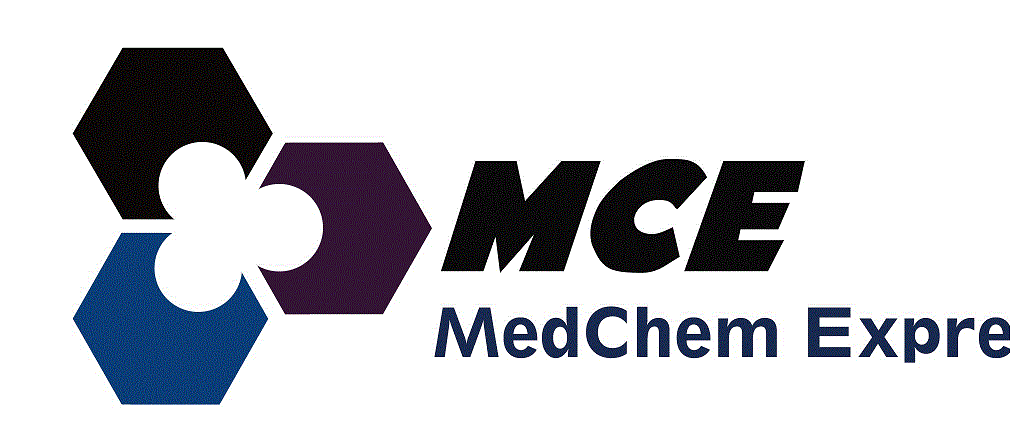MedChem Express
α-Amylase/α-Glucosidase-IN-4 (compound 5) is a dual inhibitor of α-glucosidase (Glucosidase) and α-amylase (Amylases) with IC50s of 0.15 μM and 1.10 μM, respectively. α-Amylase/α-Glucosidase-IN-4 has potential antidiabetic activity[1].
More Information
Supplier Page
MedChem Express
α-Amylase/α-Glucosidase-IN-5 (compound 4l) is a dual inhibitor of α-glucosidase (Glucosidase) and α-amylase (Amylases) with IC50s of 5.96 μM and 1.62 μM, respectively. α-Amylase/α-Glucosidase-IN-4 has potential antidiabetic activity[1].
More Information
Supplier Page
MedChem Express
α-Amylase/α-Glucosidase-IN-6 (compound 5j) is a potent dual inhibitor of α-amylase and α-glucosidase, with IC50s of 17.0 and 40.1 µM, respectively. α-Amylase/α-Glucosidase-IN-6 exhibits anti-hyperglycemic activities[1].
More Information
Supplier Page
MedChem Express
α-Amylase/α-Glucosidase-IN-7 (Compound 3f) is a competitive α-glucosidase and α-amylase enzyme inhibitor with IC50 values of 18.52 and 20.25 µM, respectively. α-Amylase/α-Glucosidase-IN-7 can also effectively inhibit AChE and BChE, with IC50 values of 9.25 and 10.06 µM respectively. α-Amylase/α-Glucosidase-IN-7 can be used in diabetes and Alzheimer’s research[1].
More Information
Supplier Page
MedChem Express
α-Amylase/α-Glucosidase-IN-8 (Compound 7p) is a potent dual inhibitor of α-amylase and α-glucosidase, with IC50s of 10.19 and 10.33 μM, respectively. α-Amylase/α-Glucosidase-IN-8 has good anti-oxidant activity(IC50 = 14.93 μM). α-Amylase/α-Glucosidase-IN-8 can be used for the research of diabetes[1].
More Information
Supplier Page
MedChem Express
MedChem Express
α-Azidothymidine is a purine nucleoside analog. Purine nucleoside analogs have broad antitumor activity targeting indolent lymphoid malignancies. Anticancer mechanisms in this process rely on inhibition of DNA synthesis, induction of apoptosis, etc[1]. α-Azidothymidine is a click chemistry reagent, it contains an Azide group and can undergo copper-catalyzed azide-alkyne cycloaddition reaction (CuAAc) with molecules containing Alkyne […]
More Information
Supplier Page
MedChem Express
MedChem Express
MedChem Express
MedChem Express
MedChem Express
α-Cembrenediol is a potent inhibitor of EBV.α-Cembrenediol inhibits the early antigen of the Epstein-Bar virus. α-Cembrenediol also has anti-tumour activity[1].
More Information
Supplier Page
MedChem Express
Isonaline 70 is a biochemical reagent that can be used as a biological material or organic compound for life science related research.
More Information
Supplier Page
MedChem Express
Isonaline 70 is a biochemical reagent that can be used as a biological material or organic compound for life science related research.
More Information
Supplier Page
MedChem Express
α-Conotoxin AuIA is a potent and selective α3β4 n-nAChR inhibitor. α-Conotoxin AuIA is a α-conotoxin that can be isolated from Conus aulicus[1].
More Information
Supplier Page
MedChem Express
α-Conotoxin Bt1.8 is a potent α6/α3β2β3 and α3β2 nAChRs inhibitor with IC50s of 2.1 nM and 9.4 nM against rat α6/α3β2β3 and α3β2, respectively[1].
More Information
Supplier Page
MedChem Express
α-Conotoxin BuIA is a paralytic peptide neurotoxin and a competitive nAChR antagonist, with IC50s of 0.258 nM (α6/α3β2), 1.54 nM (α6/α3β4), 5.72 nM (α3β2), respectively. α-Conotoxin BuIA can be used to distinguish nAChRs containing β2- and β4-subunit, respectively. α-Conotoxin BuIA distinguishes among αxβ2 nAChRs with a rank order potency of α6>α3>α2>α4[1].
More Information
Supplier Page
MedChem Express
α-Conotoxin EIIB (Alpha-conotoxin EIIB) is a toxin peptide that can be obtained from Conus ermineus. α-Conotoxin EIIB binds to nAChR (Ki=2.2 nM). α-Conotoxin EIIB can be used in the study of neurological diseases such as schizophrenia, drug addiction, Alzheimer’s disease, and Parkinson’s disease[1].
More Information
Supplier Page
MedChem Express
α-Conotoxin GI has high affinity for nAChR.α-Conotoxin GI is a short peptide toxin that can be isolated from the venom of Conus geographus.α-Conotoxin GI has the similar activity with neuromuscular blocking agent[1][2][3].
More Information
Supplier Page
MedChem Express
MedChem Express
α-Conotoxin GID is a paralytic peptide neurotoxin and a selective antagonist of nAChR, with IC50s of 5 nM (α7), 3 nM (α3β2), 150 nM (α4β2), respectively. α-Conotoxin GID is small disulfide-rich peptide, with potential to inhibit chronic pain. α-Conotoxin GID contains a C-terminal carboxylate, thus substitution with a C-terminal carboxamide results in loss of α4β2 […]
More Information
Supplier Page
MedChem Express
α-Conotoxin LtIA is an α3β2 nAChR blocker (IC50=9.8 nM), that can be obtained from Conus litteratus venom. Alpha-Conotoxin LtIA can be used in the study of neurological diseases (such as Parkinson’s disease, pain)[1].
More Information
Supplier Page
MedChem Express
α-Conotoxin MrIC is an α7nAChR biased agonist. α-Conotoxin MrIC exclusively activates α7nAChR regulated by type II positive allosteric modulators, including PNU120596. α-Conotoxin MrIC can be used to study neurological diseases and also to probe the pharmacological properties of α7nAChR[1].
More Information
Supplier Page
MedChem Express
α-Conotoxin PeIA is an analgesic α-conotoxin.α-Conotoxin PeIA inhibits the α6β4, α9α10 and α3β2 nAChR.α-Conotoxin PeIA is also a potent inhibitor of N-type calcium channel via GABAB receptor activation[1][2][3].
More Information
Supplier Page
MedChem Express
α-Conotoxin RgIA (α-RgIA) is a specific α9α10 nAChR antagonist. α-Conotoxin RgIA can be obtained from Conus regius venom. α-Conotoxin RgIA can be used in the study of neurological diseases[1].
More Information
Supplier Page
MedChem Express
α-Conotoxin TxID is a potent α3β4 nAChR antagonist with an IC50 value of 12.5 nM. α-Conotoxin TxID has weak inhibition activity of closely related α6/α3β4 nAChR (IC50= 94 nM). α-Conotoxin TxID has the potential for novel smoking cessation drug development[1].
More Information
Supplier Page
MedChem Express
MedChem Express
α-Cyclodextrin (Standard) is the analytical standard of α-Cyclodextrin. This product is intended for research and analytical applications. α-Cyclodextrin is a multifunctional, soluble dietary fiber marketed for use as a fiber ingredient[1].
More Information
Supplier Page
MedChem Express
α-Cytidine is a purine nucleoside analog. Purine nucleoside analogs have broad antitumor activity targeting indolent lymphoid malignancies. Anticancer mechanisms in this process rely on inhibition of DNA synthesis, induction of apoptosis, etc[1].
More Information
Supplier Page
MedChem Express
α-Cytidine is a purine nucleoside analog. Purine nucleoside analogs have broad antitumor activity targeting indolent lymphoid malignancies. Anticancer mechanisms in this process rely on inhibition of DNA synthesis, induction of apoptosis, etc[1].
More Information
Supplier Page
MedChem Express
α-D-altro-3-Heptulofuranose is a nature product that could be isolated from the rhizomes of Actinidia kolomikta. α-D-altro-3-Heptulofuranose has anti-inflammatory activity[1].
More Information
Supplier Page
MedChem Express
α-D-Glucosamine 1-phosphate is an E.coli metabolite. α-D-Glucosamine 1-phosphate is one of the precursors of peptidoglycan synthesis[1][2].
More Information
Supplier Page
MedChem Express
α-Dihydroartemisinin is a natural product that can be found in artemisinin. α-Dihydroartemisinin also shows antimalarial activity[1].
More Information
Supplier Page
MedChem Express
α-Eleostearic acid (cis-Eleostearic acid), a conjugated linolenic acid, is an apoptosis inducer. α-Eleostearic acid is also a ferroptosis inducer. α-Eleostearic acid exhibits antioxidant and antitumor activity[1][2][3].
More Information
Supplier Page
MedChem Express
α-Eleostearic acid (cis-Eleostearic acid), a conjugated linolenic acid, is an apoptosis inducer. α-Eleostearic acid is also a ferroptosis inducer. α-Eleostearic acid exhibits antioxidant and antitumor activity[1][2][3].
More Information
Supplier Page
MedChem Express
α-Eleostearic acid (cis-Eleostearic acid), a conjugated linolenic acid, is an apoptosis inducer. α-Eleostearic acid is also a ferroptosis inducer. α-Eleostearic acid exhibits antioxidant and antitumor activity[1][2][3].
More Information
Supplier Page
MedChem Express
α-Eleostearic acid (cis-Eleostearic acid), a conjugated linolenic acid, is an apoptosis inducer. α-Eleostearic acid is also a ferroptosis inducer. α-Eleostearic acid exhibits antioxidant and antitumor activity[1][2][3].
More Information
Supplier Page
MedChem Express
α-Eleostearic acid (cis-Eleostearic acid), a conjugated linolenic acid, is an apoptosis inducer. α-Eleostearic acid is also a ferroptosis inducer. α-Eleostearic acid exhibits antioxidant and antitumor activity[1][2][3].
More Information
Supplier Page
MedChem Express
α-Eleostearic acid (cis-Eleostearic acid), a conjugated linolenic acid, is an apoptosis inducer. α-Eleostearic acid is also a ferroptosis inducer. α-Eleostearic acid exhibits antioxidant and antitumor activity[1][2][3].
More Information
Supplier Page
MedChem Express
α-Ergostenol (Ergost-8(14)-en-3-ol) is a phytosterol isolated from the fruits of Cirsium palustre and C. rivulare.[1]
More Information
Supplier Page
MedChem Express
alpha-Galactosidase A is a lysosomal exoglycosidase and hydrolyses the terminal α-galactosyl moieties of glycoconjugates[1].
More Information
Supplier Page
MedChem Express
alpha-Galactosidase A is a lysosomal exoglycosidase and hydrolyses the terminal α-galactosyl moieties of glycoconjugates[1].
More Information
Supplier Page
MedChem Express
alpha-Galactosidase A is a lysosomal exoglycosidase and hydrolyses the terminal α-galactosyl moieties of glycoconjugates[1].
More Information
Supplier Page
MedChem Express
α-Galactosidase (EC 3.2.1.22) (EC 3.2.1.22), that is, α-galactosidase, is a glycoside hydrolase that widely exists in animals, plants and microorganisms, and is often used in biochemical research. α-Galactosidase catalyzes the hydrolysis of α-1,6-linked terminal galactose residues, including galactooligosaccharides, galactomannans, and galactolipids. Catalyzes many catabolic processes including cleavage of glycoproteins, glycolipids and polysaccharides[1].
More Information
Supplier Page
MedChem Express
α-Galactosidase (EC 3.2.1.22) (EC 3.2.1.22), that is, α-galactosidase, is a glycoside hydrolase that widely exists in animals, plants and microorganisms, and is often used in biochemical research. α-Galactosidase catalyzes the hydrolysis of α-1,6-linked terminal galactose residues, including galactooligosaccharides, galactomannans, and galactolipids. Catalyzes many catabolic processes including cleavage of glycoproteins, glycolipids and polysaccharides[1].
More Information
Supplier Page
MedChem Express
α-GLU stands for α-glucosidase. α-GLU hydrolyzes starch and disaccharides via targeting to terminal, non-reducing (1→4)-linked α-D-glucose residues to produce α-glucose. α-GLU is substrate selective[1].
More Information
Supplier Page
MedChem Express
α-GLU stands for α-glucosidase. α-GLU hydrolyzes starch and disaccharides via targeting to terminal, non-reducing (1→4)-linked α-D-glucose residues to produce α-glucose. α-GLU is substrate selective[1].
More Information
Supplier Page
MedChem Express
α-Glucosidase-IN-23 is an orally active α-Glucosidase inhibitor. α-Glucosidase-IN-23 decreases blood glucose by a-glucosidase inhibition with an IC50 value of 4.48 μM. α-Glucosidase-IN-23 can be used for the research of diabetes[1].
More Information
Supplier Page
MedChem Express
α-Glucosidase-IN-24 (Compound 13) is an α-Glucosidase inhibitor with an IC50 of 451 μM. α-Glucosidase-IN-24 can be isolated from Swertia kouitchensis[1].
More Information
Supplier Page
MedChem Express
α-Glucosidase-IN-24 (Compound 13) is an α-Glucosidase inhibitor with an IC50 of 451 μM. α-Glucosidase-IN-24 can be isolated from Swertia kouitchensis[1].
More Information
Supplier Page




